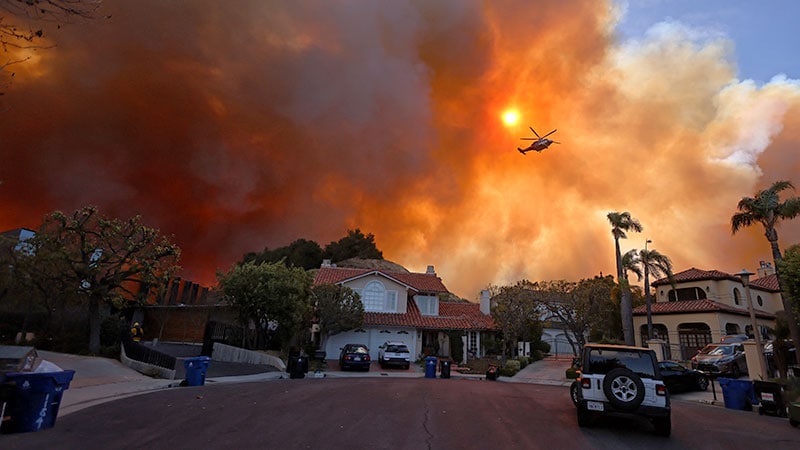As firefighters continue to battle the Palisades and Eaton fires in Los Angeles, Anne Peters, MD, and her team, have kept their attention on ensuring their patients with diabetes have the care — and supplies — they need.
Peters serves patients in both the underserved Los Angeles as well as the wealthy Beverly Hills. She took a few minutes to answer questions regarding her and her patients’ experiences as well as tips that apply to caring for patients with diabetes during other natural disasters.
Q: Can you provide some details about your patients who have been impacted by the fires?
A: Between the Palisades and the Altadena fires, approximately 100 patients lost their homes or were under mandatory evacuation. Those who lost their homes are scrambling to find places to rent. Some were lucky enough to have family in the area who are unaffected by the fire and, thus, provided a safe place to stay. In the Palisades, where many of my patients are quite wealthy, having a second home that wasn’t impacted is fairly common. However, for all who lost their homes this was a huge disruption to their lives, especially for those with school age children. The amount of destruction was unprecedented.
Q: What about their prescriptions?
A: Because these fires only impacted relatively localized parts of town, it was easy for people to get their prescriptions filled at other pharmacies in the city. Many of my insulin-requiring patients evacuated with some insulin, while others were able to obtain insulin from a different pharmacy. For my patients on other medications, those were easy to obtain because pharmacies and insurers made it possible for people to get early refills without a hassle. We did have to rewrite some prescriptions, but overall, I felt we could keep our patients supplied with what they needed.
Q: Have there been any difficulties with refilling diabetes devices lost in the fires?
A: Devices, such as continuous glucose monitors and insulin pump supplies, could be more of a challenge to help people get, but it was possible. Many patients had assembled something of a stockpile of devices and such, and those were all lost in the fires. It will take time before people are settled again with all the supplies they need.
Q: Are you worried about long-term implications, such as diminished diabetes self-management due to logistical challenges and/or psychological trauma/stress, particularly in your lower-income patients who may have already been experiencing such challenges?
A: This is a complicated question. The Palisades is a wealthy area, while Altadena is mixed. The biggest impact is that all the people from East LA working in places like the Palisades lost their jobs suddenly, which a big hardship for them. My patients in east Los Angeles still have their MediCal insurance, and our clinic is fine as it was not near the fires. The infrastructure of our healthcare system remains intact, so people could switch to another county clinic if they lost their own center. But recovering will be a challenge for all and likely more difficult for people who have fewer resources.
Q: Have you been affected personally?
A: Other than my day to day being busier, a close relative and his family lost their home so that has been a challenge. Their child is a junior in high school, so they want to stay in the area. Many of the wealthy are going to their other homes — they can live elsewhere for now. But my other patients are looking for places to live and jobs. As a healthcare provider I see the pain and grief of loss in my patients, and I feel for them.
Q: Anything you’ve learned in the past few weeks that might help other clinicians who see patients with diabetes or other chronic conditions in dealing with disaster situations?
A: The diabetes disaster response coalition is very helpful. I always make sure my patients are prepared in advance with a mobile disaster survival kit. My patients did really well overall, and whatever they were lacking, I could get for them. I think it is important to contact one’s healthcare team early in a disaster, if they are still available, so that prescriptions can be transferred. I was impressed with how many of my patients thought to grab their medications and supplies as they fled from their houses. Former swimmer Gary Hall, Jr, for instance, left his Olympic medals behind but brought his insulin as he fled from the flames (he literally had 3 minutes to leave). He didn’t remember his pen needles, but we were able to immediately find a nearby pharmacy and arrange for him to pick them up.
Q: Any positive stories to end on?
A: I learned that being prepared helps. There has been an outpouring of assistance. Lots of organizations have been involved including the Red Cross and the Humane Society (for all the animals who needed help). One of my patients had stored everything historical that mattered to her in a firesafe temperature-controlled storage unit in a different location so she didn’t so lose much of her children’s past. Having all important photos stored digitally is a good idea. The same holds true for important papers and documents. Material possessions seem to have great meaning to people, but what matters most is a sense of home and community. These can be rebuilt.
As long as people and pets are safe, healing can happen more quickly than people imagine. Personally, I’m not connected to material things — I have almost none I can’t live without, but I love my patients and my job and my connections, so I realized I want to stay in LA — fires, earthquakes, mudslides, and all.
Source link : https://www.medscape.com/viewarticle/caring-patients-diabetes-during-los-angeles-fires-2025a10001lr?src=rss
Author :
Publish date : 2025-01-23 06:40:00
Copyright for syndicated content belongs to the linked Source.
